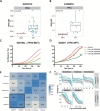TP53 mutated glioblastoma stem-like cell cultures are sensitive to dual mTORC1/2 inhibition while resistance in TP53 wild type cultures can be overcome by combined inhibition of mTORC1/2 and Bcl-2
- PMID: 27533080
- PMCID: PMC5295441
- DOI: 10.18632/oncotarget.11205
TP53 mutated glioblastoma stem-like cell cultures are sensitive to dual mTORC1/2 inhibition while resistance in TP53 wild type cultures can be overcome by combined inhibition of mTORC1/2 and Bcl-2
Abstract
Background: Glioblastoma is the most malignant tumor of the central nervous system and still lacks effective treatment. This study explores mutational biomarkers of 11 drugs targeting either the RTK/Ras/PI3K, the p53 or the Rb pathway using 25 patient-derived glioblastoma stem-like cell cultures (GSCs).
Results: We found that TP53 mutated GSCs were approximately 3.5 fold more sensitive to dual inhibition of mammalian target of rapamycin complex 1 and 2 (mTORC1/2) compared to wild type GSCs. We identified that Bcl-2(Thr56/Ser70) phosphorylation contributed to the resistance of TP53 wild type GSCs against dual mTORC1/2 inhibition. The Bcl-2 inhibitor ABT-263 (navitoclax) increased sensitivity to the mTORC1/2 inhibitor AZD8055 in TP53 wild type GSCs, while sensitivity to AZD8055 in TP53 mutated GSCs remained unchanged.
Conclusion: Our data suggest that Bcl-2 confers resistance to mTORC1/2 inhibitors in TP53 wild type GSCs and that combined inhibition of both mTORC1/2 and Bcl-2 is worthwhile to explore further in TP53 wild type glioblastomas, whereas in TP53 mutated glioblastomas dual mTORC1/2 inhibitors should be explored.
Keywords: brain tumor; genetic biomarkers; personalized medicine; resistance; small molecule kinase inhibitors.
Conflict of interest statement
The authors declare no competing financial interests.
Figures



References
-
- Ohgaki H, Kleihues P. Population-based studies on incidence, survival rates, and genetic alterations in astrocytic and oligodendroglial gliomas. J Neuropathol Exp Neurol. 2005;64:479–489. - PubMed
-
- Stupp R, Mason WP, van den Bent MJ, Weller M, Fisher B, Taphoorn MJ, Belanger K, Brandes AA, Marosi C, Bogdahn U, Curschmann J, Janzer RC, Ludwin SK, Gorlia T, Allgeier A, Lacombe D, et al. Radiotherapy plus concomitant and adjuvant temozolomide for glioblastoma. N Engl J Med. 2005;352:987–996. - PubMed
-
- Prados MD, Byron SA, Tran NL, Phillips JJ, Molinaro AM, Ligon KL, Wen PY, Kuhn JG, Mellinghoff IK, de Groot JF, Colman H, Cloughesy TF, Chang SM, Ryken TC, Tembe WD, Kiefer JA, et al. Toward precision medicine in glioblastoma: the promise and the challenges. Neuro Oncol. 2015;17:1051–1063. - PMC - PubMed
-
- Sleijfer S, Bogaerts J, Siu LL. Designing transformative clinical trials in the cancer genome era. J Clin Oncol. 2013;31:1834–1841. - PubMed
MeSH terms
Substances
LinkOut - more resources
Full Text Sources
Other Literature Sources
Medical
Molecular Biology Databases
Research Materials
Miscellaneous

